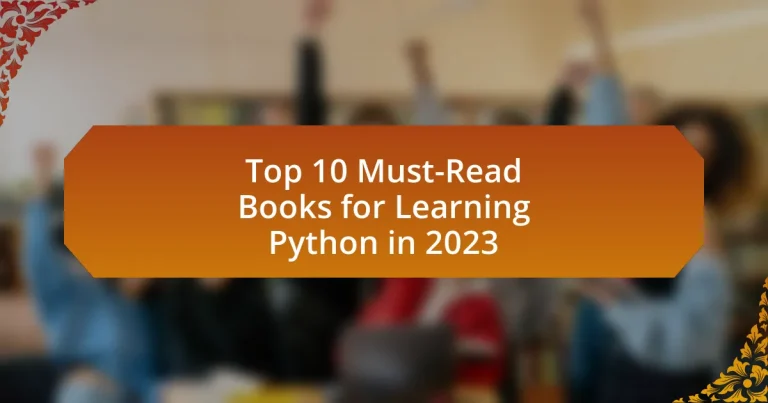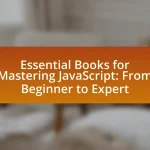The article presents the top 10 must-read books for learning Python in 2023, highlighting essential resources for learners at various skill levels. Key titles include “Automate the Boring Stuff with Python,” “Python Crash Course,” and “Fluent Python,” each offering comprehensive coverage of programming concepts, practical examples, and hands-on projects. The article emphasizes the importance of selecting quality books based on credibility, relevance, and learning style, while also discussing how different learning styles affect book selection. Additionally, it outlines the foundational topics covered in beginner books and contrasts them with advanced resources, providing insights into how learners can effectively transition from basic to advanced Python programming.
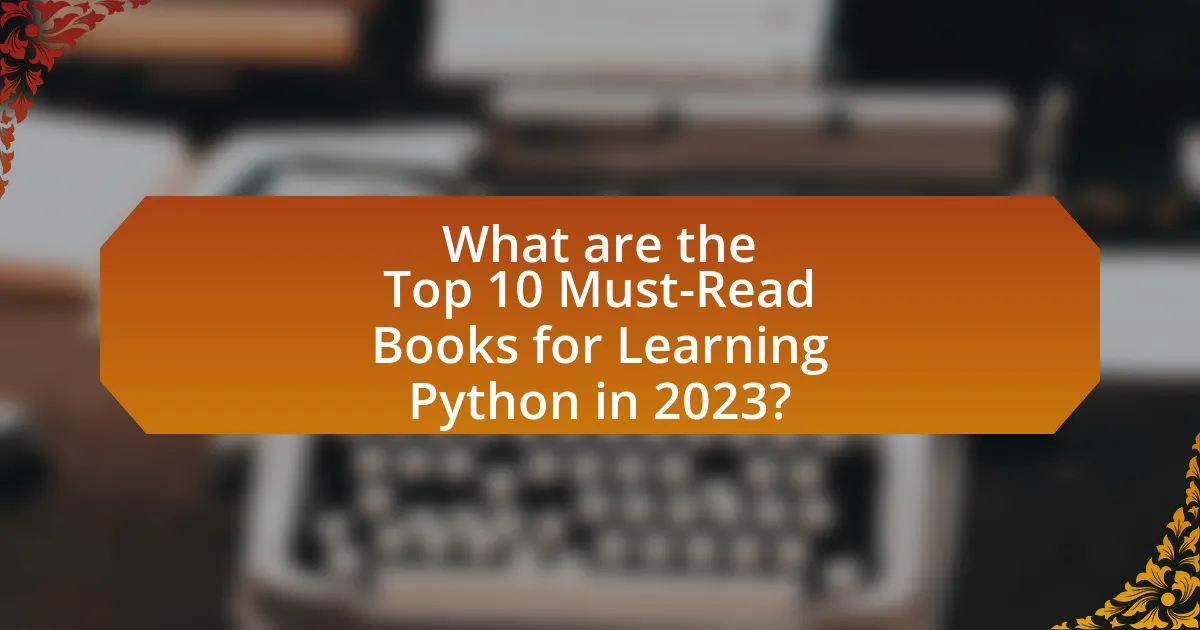
What are the Top 10 Must-Read Books for Learning Python in 2023?
The top 10 must-read books for learning Python in 2023 are:
- “Automate the Boring Stuff with Python” by Al Sweigart
- “Python Crash Course” by Eric Matthes
- “Learning Python” by Mark Lutz
- “Fluent Python” by Luciano Ramalho
- “Effective Python” by Brett Slatkin
- “Python for Data Analysis” by Wes McKinney
- “Head First Python” by Paul Barry
- “Python Cookbook” by David Beazley and Brian K. Jones
- “Deep Learning with Python” by François Chollet
- “Think Python” by Allen B. Downey
These books cover a range of topics from basic programming concepts to advanced applications in data science and machine learning, making them essential resources for learners at all levels.
Why is it important to choose the right books for learning Python?
Choosing the right books for learning Python is crucial because they significantly influence the learner’s understanding and proficiency in the language. Quality books provide structured content, clear explanations, and practical examples that cater to different learning styles, which enhances comprehension and retention. For instance, books that include hands-on exercises allow learners to apply concepts in real-world scenarios, reinforcing their skills. Furthermore, well-reviewed books often reflect current best practices and up-to-date information, ensuring that learners are equipped with relevant knowledge. Selecting appropriate resources can lead to more efficient learning, reducing frustration and increasing motivation, ultimately resulting in a more effective educational experience.
What criteria should be considered when selecting Python learning resources?
When selecting Python learning resources, consider the resource’s credibility, relevance to your skill level, and the learning format. Credibility is essential; resources authored by recognized experts or institutions ensure quality content. Relevance to your skill level ensures that the material is neither too advanced nor too basic, facilitating effective learning. The learning format, whether it be books, online courses, or interactive tutorials, should align with your preferred learning style to enhance engagement and retention.
How do different learning styles affect book selection?
Different learning styles significantly influence book selection by guiding individuals toward resources that align with their preferred methods of absorbing information. For instance, visual learners may prefer books with diagrams and illustrations, while auditory learners might seek out texts that include discussions or accompanying audio materials. Kinesthetic learners often favor hands-on guides or books that incorporate exercises and practical applications. Research indicates that tailoring book choices to these learning styles can enhance comprehension and retention, as evidenced by studies showing that learners perform better when engaging with materials that match their learning preferences.
What are the key features of the best Python books in 2023?
The key features of the best Python books in 2023 include comprehensive coverage of Python fundamentals, practical examples, and hands-on projects. These books emphasize clarity in explanations, making complex concepts accessible to beginners while also providing advanced topics for experienced programmers. Additionally, they often include updated content reflecting the latest Python versions and libraries, ensuring relevance in a rapidly evolving programming landscape. Many of these books also incorporate interactive elements, such as online resources or coding exercises, to enhance the learning experience.
How do practical exercises enhance learning in Python books?
Practical exercises enhance learning in Python books by providing hands-on experience that reinforces theoretical concepts. Engaging in coding exercises allows learners to apply what they have read, facilitating deeper understanding and retention of programming principles. Research indicates that active learning techniques, such as coding practice, can improve knowledge retention by up to 75% compared to passive reading alone. This active engagement helps learners identify and correct mistakes in real-time, fostering problem-solving skills essential for programming.
What role does author expertise play in the effectiveness of a Python book?
Author expertise significantly enhances the effectiveness of a Python book by ensuring accurate, relevant, and practical content. Experienced authors bring a deep understanding of Python’s intricacies, which allows them to present complex concepts clearly and effectively. For instance, authors with professional backgrounds in software development or data science can provide real-world examples and best practices that resonate with learners. This expertise not only boosts the credibility of the material but also increases the likelihood that readers will successfully apply the knowledge gained, as evidenced by studies showing that learners benefit from instruction by knowledgeable practitioners.
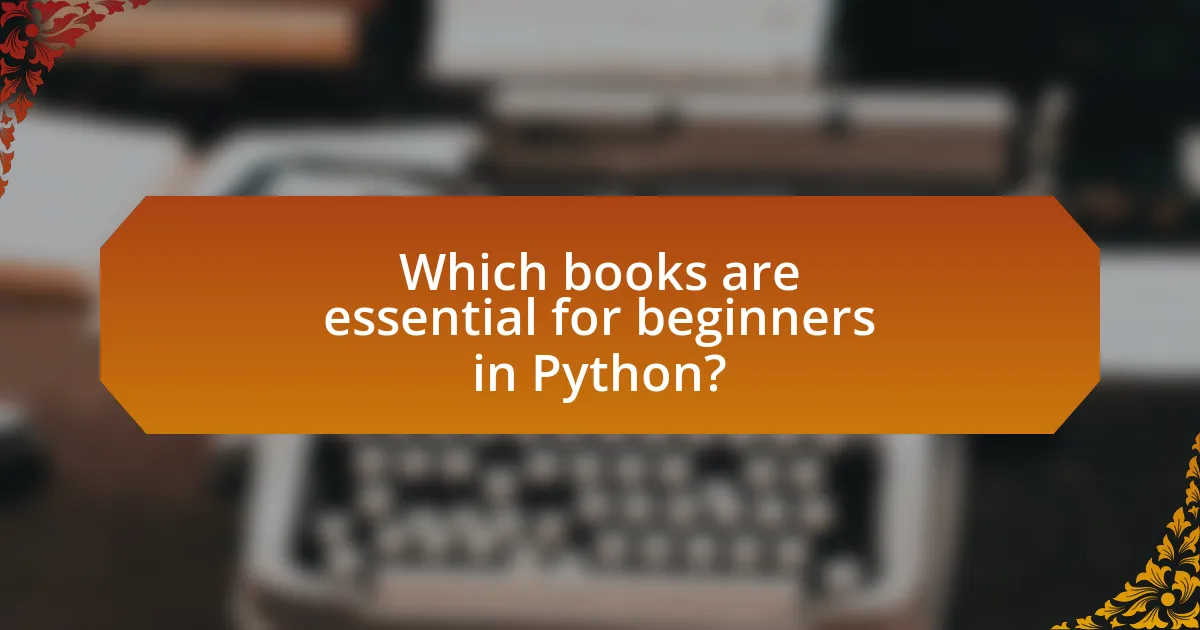
Which books are essential for beginners in Python?
Essential books for beginners in Python include “Automate the Boring Stuff with Python” by Al Sweigart, which focuses on practical programming for total beginners, and “Python Crash Course” by Eric Matthes, known for its hands-on approach and clear explanations. Additionally, “Learning Python” by Mark Lutz provides a comprehensive introduction to the language, while “Head First Python” by Paul Barry uses a visually rich format to engage learners. These books are widely recommended in educational resources and programming communities for their effectiveness in teaching foundational Python skills.
What are the top beginner-friendly Python books for 2023?
The top beginner-friendly Python books for 2023 include “Automate the Boring Stuff with Python” by Al Sweigart, “Python Crash Course” by Eric Matthes, and “Head First Python” by Paul Barry. “Automate the Boring Stuff with Python” is widely recommended for its practical approach to learning Python through real-world projects, making it accessible for beginners. “Python Crash Course” offers a comprehensive introduction to Python fundamentals, followed by hands-on projects that reinforce learning. “Head First Python” employs a visually rich format to engage readers and simplify complex concepts, making it suitable for those new to programming. These books are recognized for their clarity, practical examples, and supportive learning environments, making them ideal choices for beginners in 2023.
How do these books simplify complex concepts for new learners?
These books simplify complex concepts for new learners by breaking down intricate topics into manageable sections and using clear, relatable examples. For instance, many of the recommended Python books employ step-by-step tutorials that guide learners through coding exercises, reinforcing understanding through practice. Additionally, visual aids such as diagrams and flowcharts are often included to illustrate abstract ideas, making them more accessible. Research indicates that instructional materials that incorporate varied teaching methods, such as those found in these books, enhance comprehension and retention, particularly for beginners in programming.
What foundational topics do these beginner books cover?
Beginner books on Python cover foundational topics such as basic syntax, data types, control structures, functions, and error handling. These topics establish a solid understanding of programming principles, enabling learners to write simple programs and solve problems effectively. For instance, mastering basic syntax allows beginners to understand how to structure their code, while knowledge of data types is crucial for managing different kinds of information. Control structures, including loops and conditionals, help learners dictate the flow of their programs, and functions promote code reusability. Error handling teaches beginners how to manage exceptions, ensuring their programs run smoothly.
How do these beginner books compare to advanced Python resources?
Beginner books provide foundational knowledge and practical examples for new Python learners, while advanced Python resources delve into complex topics, optimization, and specialized libraries. Beginner books typically cover basic syntax, data structures, and introductory programming concepts, making them accessible for novices. In contrast, advanced resources often assume prior knowledge and focus on advanced algorithms, design patterns, and performance tuning. For instance, a beginner book like “Automate the Boring Stuff with Python” emphasizes practical applications, whereas an advanced resource such as “Fluent Python” explores Python’s advanced features and idiomatic usage. This distinction highlights the varying depth and complexity of content tailored to different skill levels.
What advanced topics should learners expect in higher-level Python books?
Learners should expect advanced topics in higher-level Python books to include concurrency and parallelism, metaprogramming, decorators, context managers, and asynchronous programming. These topics are essential for developing efficient and scalable applications. For instance, concurrency and parallelism allow for the execution of multiple tasks simultaneously, enhancing performance in data-intensive applications. Metaprogramming enables programmers to write code that manipulates code itself, providing flexibility and reducing redundancy. Decorators and context managers are advanced features that streamline code and manage resources effectively. Asynchronous programming is crucial for handling I/O-bound tasks efficiently, making it a vital skill in modern web development.
How can beginners transition to advanced Python books effectively?
Beginners can transition to advanced Python books effectively by first solidifying their foundational knowledge through practical exercises and projects. Engaging in hands-on coding helps reinforce concepts and prepares learners for more complex topics. Additionally, beginners should select advanced books that include practical examples and exercises, as these resources often bridge the gap between theory and application. Research indicates that active learning techniques, such as coding challenges and peer discussions, enhance comprehension and retention of advanced material. By gradually increasing the complexity of the topics they study and consistently applying what they learn, beginners can build the confidence and skills necessary to tackle advanced Python literature.
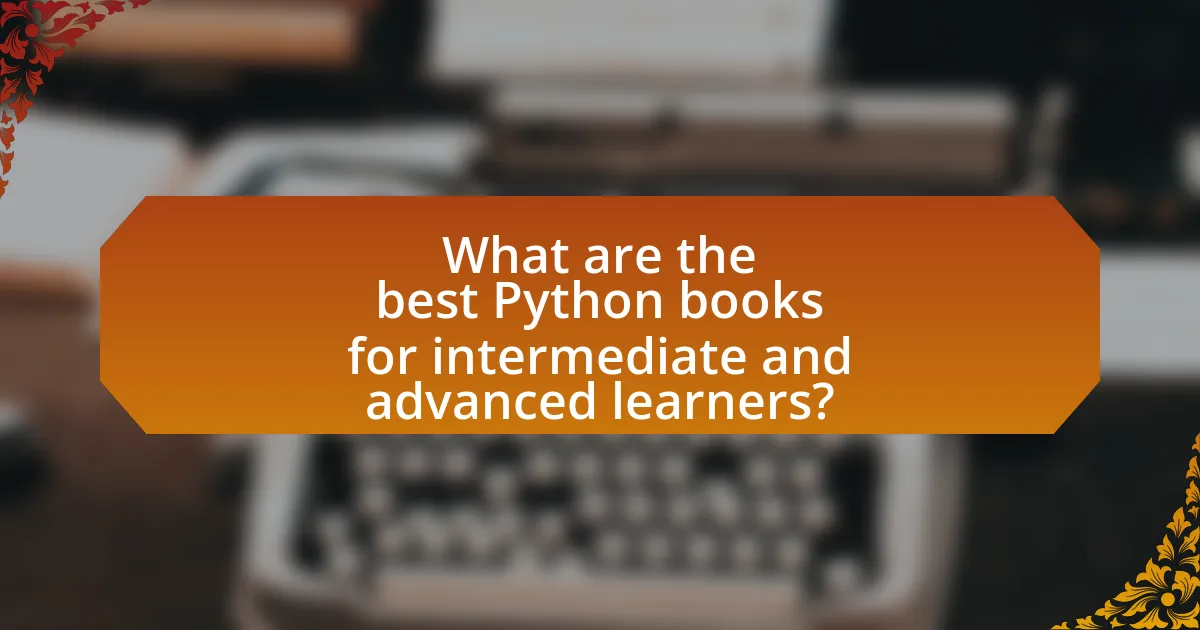
What are the best Python books for intermediate and advanced learners?
The best Python books for intermediate and advanced learners include “Fluent Python” by Luciano Ramalho, which focuses on Python’s advanced features and idiomatic practices, and “Effective Python” by Brett Slatkin, offering 90 specific ways to write better Python code. Additionally, “Python Cookbook” by David Beazley and Brian K. Jones provides practical recipes for various programming tasks, while “Learning Python” by Mark Lutz covers deeper concepts and techniques. These books are widely recognized for their depth and practical insights, making them essential for those looking to enhance their Python skills.
Which books focus on specialized areas of Python programming?
Books that focus on specialized areas of Python programming include “Fluent Python” by Luciano Ramalho, which delves into Python’s advanced features and best practices, and “Python for Data Analysis” by Wes McKinney, which is centered on data manipulation and analysis using pandas. Additionally, “Automate the Boring Stuff with Python” by Al Sweigart targets practical programming for everyday tasks, while “Deep Learning with Python” by François Chollet focuses on implementing deep learning algorithms using Python and Keras. Each of these books provides in-depth knowledge and practical applications tailored to specific domains within Python programming.
What topics do these specialized books cover?
These specialized books cover a range of topics essential for learning Python, including programming fundamentals, data structures, algorithms, web development, data analysis, machine learning, and automation. Each book typically focuses on practical applications, best practices, and real-world examples to enhance the reader’s understanding and proficiency in Python. For instance, books may delve into specific libraries like Pandas for data manipulation or Flask for web applications, providing targeted knowledge that aligns with current industry standards and practices.
How can these books enhance a programmer’s skill set?
These books can enhance a programmer’s skill set by providing in-depth knowledge of Python programming concepts, practical coding techniques, and best practices. For instance, books like “Automate the Boring Stuff with Python” teach automation skills that improve efficiency in coding tasks, while “Fluent Python” deepens understanding of Python’s advanced features, enabling programmers to write more effective and idiomatic code. Additionally, “Python Crash Course” offers hands-on projects that reinforce learning through practical application, which is crucial for skill development. Collectively, these resources equip programmers with both foundational and advanced skills necessary for tackling real-world programming challenges.
What are the benefits of reading multiple Python books?
Reading multiple Python books enhances understanding and mastery of the language by exposing learners to diverse perspectives, techniques, and problem-solving approaches. This variety helps solidify foundational concepts, as different authors may explain the same topic in unique ways, catering to various learning styles. Additionally, engaging with multiple resources allows readers to stay updated on the latest practices and libraries, as the Python ecosystem evolves rapidly. Research indicates that varied reading materials can improve retention and comprehension, making it easier for learners to apply their knowledge in practical scenarios.
How does exposure to different authors and perspectives improve understanding?
Exposure to different authors and perspectives enhances understanding by providing diverse viewpoints and methodologies, which fosters critical thinking and deeper comprehension. When learners engage with various authors, they encounter unique explanations, examples, and problem-solving approaches that can clarify complex concepts. For instance, a study by the National Education Association found that exposure to multiple perspectives in educational materials leads to improved analytical skills and greater retention of information. This variety not only enriches the learning experience but also encourages adaptability in applying knowledge to real-world scenarios.
What strategies can be used to integrate knowledge from various books?
To integrate knowledge from various books, one effective strategy is to create a thematic outline that categorizes key concepts and ideas. This approach allows for the identification of overlapping themes and unique perspectives across different texts. For instance, when studying Python, readers can organize topics such as data structures, algorithms, and libraries, aligning content from multiple sources like “Automate the Boring Stuff with Python” and “Python Crash Course.” This method not only facilitates comprehension but also enhances retention by connecting related information. Additionally, summarizing insights in one’s own words and discussing them with peers can further solidify understanding and reveal gaps in knowledge.
What practical tips can enhance the learning experience with Python books?
To enhance the learning experience with Python books, readers should actively engage with the material by practicing coding alongside the text. This approach allows learners to apply concepts in real-time, reinforcing understanding and retention. Research indicates that active learning techniques, such as coding exercises, significantly improve comprehension and skill acquisition in programming (Freeman et al., 2014, “Active Learning Increases Student Performance in Science, Engineering, and Mathematics,” Proceedings of the National Academy of Sciences). Additionally, readers should take notes and summarize key points to solidify their grasp of the material, as this method has been shown to enhance memory retention (Mueller & Oppenheimer, 2014, “The Pen Is Mightier Than the Keyboard: Advantages of Longhand Over Laptop Note Taking,” Psychological Science).
How can readers effectively take notes while studying Python books?
Readers can effectively take notes while studying Python books by employing the Cornell note-taking system, which enhances retention and understanding. This method involves dividing the page into three sections: cues, notes, and summary. In the notes section, readers should write down key concepts, code snippets, and examples as they read, ensuring they capture the main ideas and details. The cues section is used for questions or keywords that prompt recall, while the summary section at the bottom allows for a concise recap of the material covered. Research indicates that structured note-taking methods like the Cornell system improve information retention by up to 34%, making it a practical choice for mastering Python concepts.
What are the best practices for applying knowledge gained from Python books?
The best practices for applying knowledge gained from Python books include actively coding projects, participating in coding challenges, and contributing to open-source projects. Actively coding projects reinforces concepts learned and helps in understanding practical applications. Engaging in coding challenges, such as those on platforms like LeetCode or HackerRank, enhances problem-solving skills and familiarity with Python syntax. Contributing to open-source projects allows learners to collaborate with others, gain real-world experience, and understand how Python is used in various applications. These practices are supported by the fact that hands-on experience is crucial for mastering programming languages, as evidenced by studies showing that active learning significantly improves retention and application of knowledge.
